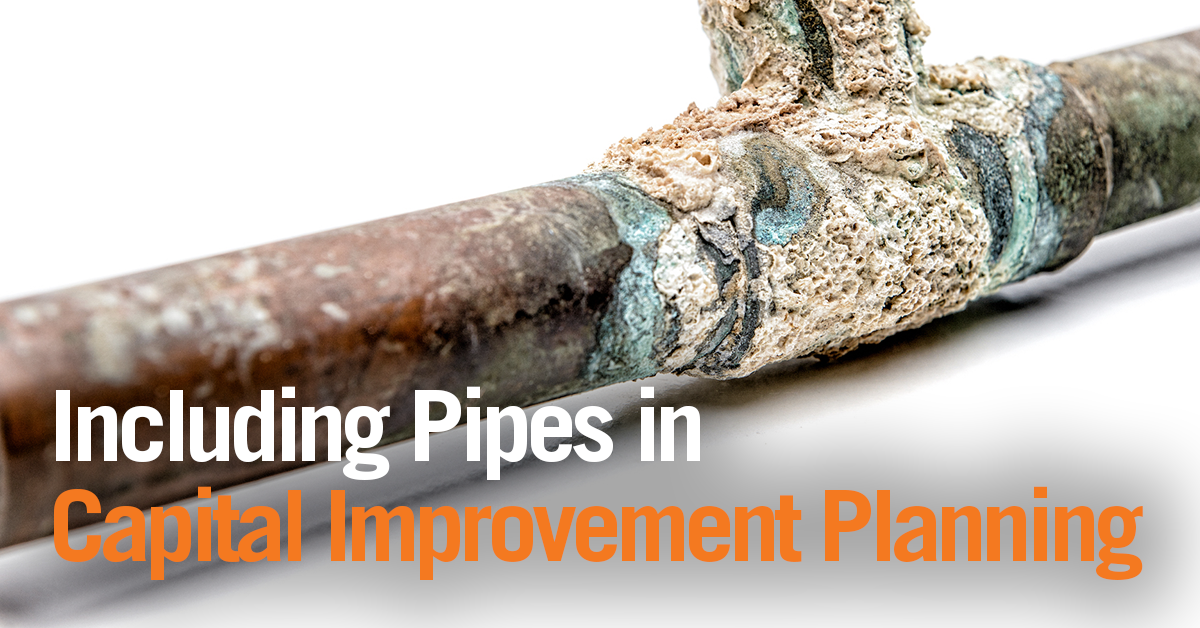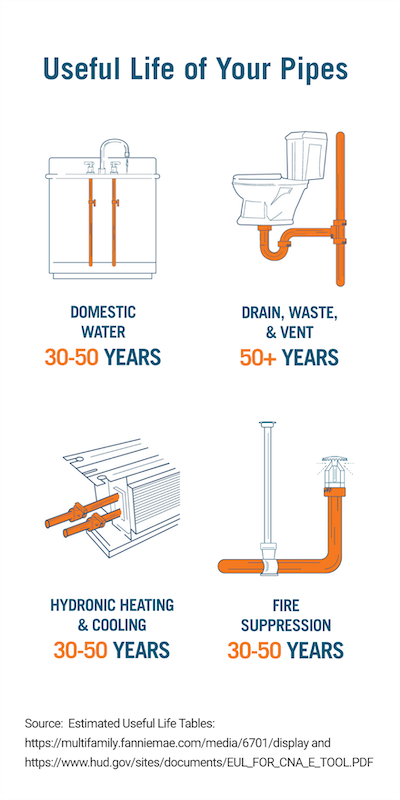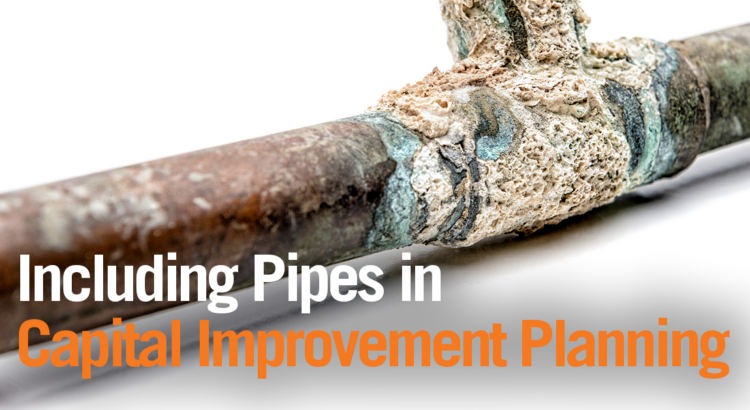
Including Pipes in Capital Improvement Planning
Leverage Useful Life Estimates, Incident Tracking, and Pipe Assessments to Prepare Your Community for the Inevitable
Movie boxing legend Rocky Balboa once opined that “time is undefeated.” You don’t have to manage an apartment or condominium community for very long to know he’s right. You quickly realize that all building components eventually need to be replaced—roofs, siding, windows, and even pipes.
Maybe you’ve never considered that you may one day have to replace a whole piping system in your community. The fact is, it’s becoming more common. Based on the age of America’s multifamily buildings, we estimate that 40% of U.S. apartment and condominium communities will need to replace at least one major piping system in the next 10 years.
These “repipes” are significant capital investments that owners and operators sometimes hesitate to undertake. In the end, however, the projects are necessary to protect a community’s value and resident safety. How can you better anticipate when your community will need to replace an aging or defective piping system? When a system is failing, what information can you use to assess your repipe options?
Here are a few tools and best practices you can employ to answer these questions and ensure pipes are included in your capital improvement planning.
Estimating the Useful Life of Your Pipes
Leaks, floods, water shutoffs, mold, harmful gasses—the consequences of pipe failure dramatically disrupt residents’ lives and even endanger their health. Frequent and catastrophic system failures can also drive up your insurance rates and deductibles, tarnish your brand image, drive renters away, and invoke lawsuits from condo owners. That list doesn’t even include the costs to fix all the damage.
So how can you know when your piping systems may fail? The answer varies by system and your piping material; copper, galvanized steel, CPVC, PEX and other materials each have different lifespans. You can start by comparing the age of your building with the Fannie Mae and HUD Estimated Useful Life (EUL) tables.
Our data agrees with these estimates. In our database, we’ve analyzed 10 years of repipe needs at 400 apartment and condominium communities with 50 units or more. On average, we replaced domestic supply systems when community buildings were 34.5 years old, DWV systems when buildings were 47.5 years old, and hydronic piping when buildings were about 55 years old.
Bear in mind, your community may need a pipe replacement sooner due to environmental factors like poor water quality or a manufacturer or construction defect. For example, if you have a known defective product like polybutylene, you need to replace your piping right away!
Managing Risks and Tracking Issues
There are plenty of steps you can take to prolong the useful life of your pipes and detect tell-tale signs of failure. Start small with a disciplined maintenance program that includes, for example, regularly cleaning your drain lines and exercising your shut-off valves. Also, diligently track incidents across your building with a tool like the SageWater Leak Log. This way, you’ll have a record that survives management turnover and differentiates new problems from recurring ones.
As your community ages, or as you detect more plumbing issues, introduce pipe assessments to better inform your operational and capital improvement planning.

Assessing the Condition of Your Pipes
Pipe assessments are produced by certified experts who use a variety of techniques to report on the condition of piping systems. The assessments provide everyone from owners and operators to investors and buyers with the information and confidence to decide if, when, and how to take action on failing pipes. This is very helpful insight for managing a single community and can be especially valuable for owners and operators making capital improvement decisions across a portfolio of communities.
Regulations may mandate building inspections that include plumbing, which can help you judge when to budget for pipe assessments. In the absence of regulations, plan to perform your first assessment 20 years after your building was built or as soon as you detect signs of piping failures.
Pipe Assessment Techniques
Certified technicians use a variety of techniques to assess a building’s piping systems, with all findings reviewed by professional engineers. The technique often depends on the specifics of each piping system, material, and client needs. Examples include:
Camera-Based Assessments for Drain, Waste, and Vent Systems. Feed a camera through the pipes for a visual inspection and provide an industry-standard defect score for each section of pipe.
Ultrasonic Assessments. Attach an ultrasonic meter to the pipe’s exterior and send a pulse through the material to determine pipe thickness and detect any deterioration of inner pipe walls.
Pipe Sampling/Fitting Extractions. Remove small sections of pipe and/or fittings and send them to a lab for testing.
One important note: Always obtain assessments from certified professionals, usually forensic engineers. You can obtain a standard report, which helps you learn precisely where and why your piping is failing. At SageWater, we couple our assessment reports with guidance and recommendations for an appropriate course of action; if findings indicate the piping must be replaced, we’ll also provide a rough estimate of the potential project cost and timeline.
Once you have the facts from your pipe assessment, you can make smarter decisions about funding and solving piping system failures. For example:
- You might choose a water treatment system for a failing copper domestic line, which can buy you precious time for pulling together resources for a longer-term fix.
- You can also opt for ongoing repairs, but fair warning: Treating a systemic issue with a piecemeal approach is a guaranteed way to add costs and frustration, along with issues we mentioned earlier about renter and owner dissatisfaction.
- You might also act fast to take advantage of still-favorable lending rates by financing a repipe. You’ll effectively reset the clock on your building, gaining new warrantees and decades of trouble-free plumbing. This also helps ward off future price increases due to inflation.
Take Advantage of Your Options
You have multiple options for factoring pipes into your capital improvement planning and avoiding costly surprises. Disciplined maintenance programs and incident tracking are essential; pipe assessments can be predictive and thorough. Rocky may have been right: You can’t beat time. But you sure can give it a run for its money.
We’d love to hear from you.
Thanks for reading our blog! Contact us any time with questions about Simply Smarter Pipe Replacement for multifamily apartment and condominium communities.


